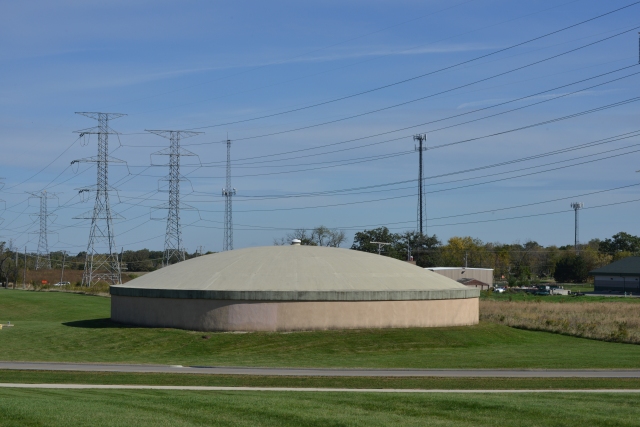Story and photos by Kristen Cart
At first glance, a water storage tank and a grain elevator seem to have a few things in common, both in function and appearance, though they present a number of differing engineering challenges. I had the opportunity to interview Joseph Carroll, a project superintendent for D N Tanks, while flying on a commercial airline to start one of my trips. When he realized the lady sitting next to him had some engineering background, and actually was interested in concrete construction methods, he warmed to his subject with enthusiasm.
I wanted to find out how the construction of a tank answered the problems that grain elevator designs had to address–the management of stress (both vertical and lateral), the aging of the tank, interior access, wrecking out, weather considerations, and basic construction methods.
D N Tanks had been in the business since 1949, and some of their tanks (still in service) were built before 1950. During the heyday of elevator building, when our grandfathers operated at the cutting edge of concrete design, water tank builders were innovating right alongside them. The types of problems they had to solve had common elements with those of elevator designers, but their solutions were widely divergent.
After looking at our Tillotson construction specifications, Mr. Carroll commented that the design bearing load (the pressure of the water against the tank walls, expressed in pounds per square inch) of his tanks is about double the bearing load in a grain elevator. Elevator builders relied on a continuous concrete pour and steel reinforcement to provide the required strength. Obviously, something had to be done differently to build a water tank that would sustain that kind of load.
D N Tanks, instead, builds tank panels which are poured in curved sections separately, then tensioned externally with wire winding as they are assembled on site.
Cold weather also creates a design challenge for concrete construction. I mentioned that in Canada, wood construction for grain elevators was preferred, because rigid concrete could crack under differential heating–an elevator would experience freezing temperatures on one side and solar heating on the other. Water tanks require insulation to prevent freezing, though they can handle surface freezing to the depth of about six inches. The tank walls are built thicker, and an insulating material of styrofoam blankets the tank exterior for installations in Alaska and other northern locations.
After the concrete roof is poured, wrecking-out is required (internal wooden concrete forms are removed). It is a process required for both elevator bins and tanks. Elevators retain the manholes used to remove the wrecking-out debris for later access to bin bottoms for cleaning. For water tanks, an access opening is left at the side to permit this process, but it is sealed afterwards. No access is needed from the side, because under normal use, the tank remains filled with water. Access to electrical systems for the pumps is from the top.
Concrete elevators are subject to much more wear and tear than water tanks. Internal friction is an issue with grain elevators: filling and emptying of grain bins abrades the inner concrete surfaces, eventually causing cracking and damage after many years. Tanks suffer from no such problems.
Fire is an ever present danger in grain elevators, and cleanliness is a constant battle. Tanks tend to be cleaner and safer, and if built correctly from the start, will long outlast the most robust grain elevator.
 I happened upon one of these water storage facilities, built by D N Tanks, while attending my son’s football game at Cary Junior High School in northern Illinois. It appeared just as Mr. Carroll described as a typical D N Tank project: it was bordered with a two-foot wide lip, and topped with a white vent.
I happened upon one of these water storage facilities, built by D N Tanks, while attending my son’s football game at Cary Junior High School in northern Illinois. It appeared just as Mr. Carroll described as a typical D N Tank project: it was bordered with a two-foot wide lip, and topped with a white vent.
The tanks are built in cities and towns to comply with a requirement for an emergency water supply. The tank or tanks must hold enough water to last for three days after normal municipal service is lost. Unlike the many grain elevators that dot the Midwest, which rise to monumental heights, these tanks are designed to blend seamlessly into the community with as little visual impact as possible. The D N Tank website pictures a number of disguises, including architectural treatments, and fully underground construction.
D N Tanks also produces tanks for glycol used for aircraft deicing, water treatment tanks, and various other tank types.
